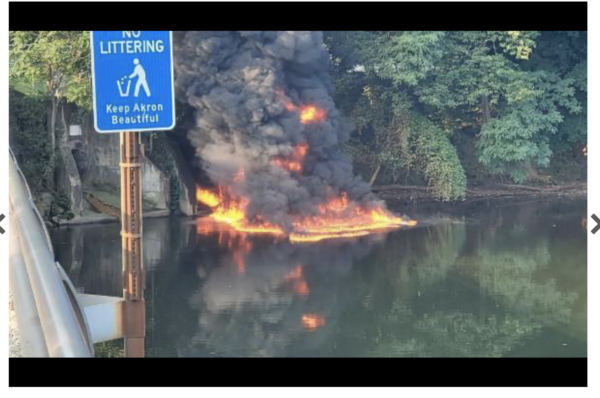
How many of you had “Cuyahoga River catches fire” on your 2020 bingo card?
Yet that’s what happened today.
A tanker-car collision/fire near the Cuyahoga River in Akron this morning spilled burning fuel into a storm sewer and then the river, so the river caught fire. This is the first time in 51 years and 2 months that the Cuyahoga River has burned.
When it comes to fires on the Cuyahoga River, the burning river jokes are inevitable. But there are some real, substantive differences between this small fire and the fires of 50+ years ago.
Today we have a clear point source of the fuel and fire making it into the otherwise nonflammable river in Akron.
50+ years ago, there were many, many point sources & non-point sources of pollution that made the river itself flammable (in Cleveland, near the mouth), and all it took was a sufficient spark. The Cuyahoga burned more than once (13 times before today), and so did rivers in other industrial cities in the US.
The Cuyahoga’s historical fires made it the burning river that “sparked” the environmental movement in the late 1960s/early 1970s. Both local grassroots and national efforts have led to dramatic improvements in water quality since then. The Cuyahoga River still has some issues, but flammability isn’t among them. NE Ohio is justifiably proud of the rebirth of its rivers and its history of environmental work. And we should be.
Today’s event reminds us that we need to keep our environmental protections strong and not backslide on regulation. We need to fill the gaps in those regulations, not widen them.
River fires need to remain extraordinarily rare, small, easily-contained events that are sobering reminders of our history, not re-enactments.
And today’s events should spur us to better manage stormwater, so that the river to roadway connection is indirect, not a pipeline for a blaze. The same connection that allowed burning fuels to reach the river today, allows road salt, metals, and many other pollutants to enter the river every time it rains or the snow melts. These direct connections between roads and rivers are everywhere and they are a major remaining source of pollution for rivers like the Cuyahoga. If you care about the health of rivers and streams (and apparently, if you don’t want them to risk catching fire), you should be pushing for stronger stormwater management, including retrofitting stormwater controls into existing roadways and developed areas.
If you want to learn more about the environmental history of the Cuyahoga River, I highly recommend this documentary. Today’s accident and fire occurred a short distance upstream of the Akron Gorge Dam, which features in the film as one of the last major impediments to water quality on the middle river. The dam is currently slated to be removed sometime in the next 3 years or so.
[Photo by Cuyahoga Falls Fire Department, via Akron Beacon Journal. Story here: https://www.beaconjournal.com/…/one-dead-in-fiery-route-8-n…. My heart goes out to the families of the people killed and injured in the accident, and my sympathy goes to those who faced the disruption of evacuation from nearby homes and workplaces or a significant time spent stuck on the road.]



Nice plan for content warnings on Mastodon and the Fediverse. Now you need a Mastodon/Fediverse button on this blog.